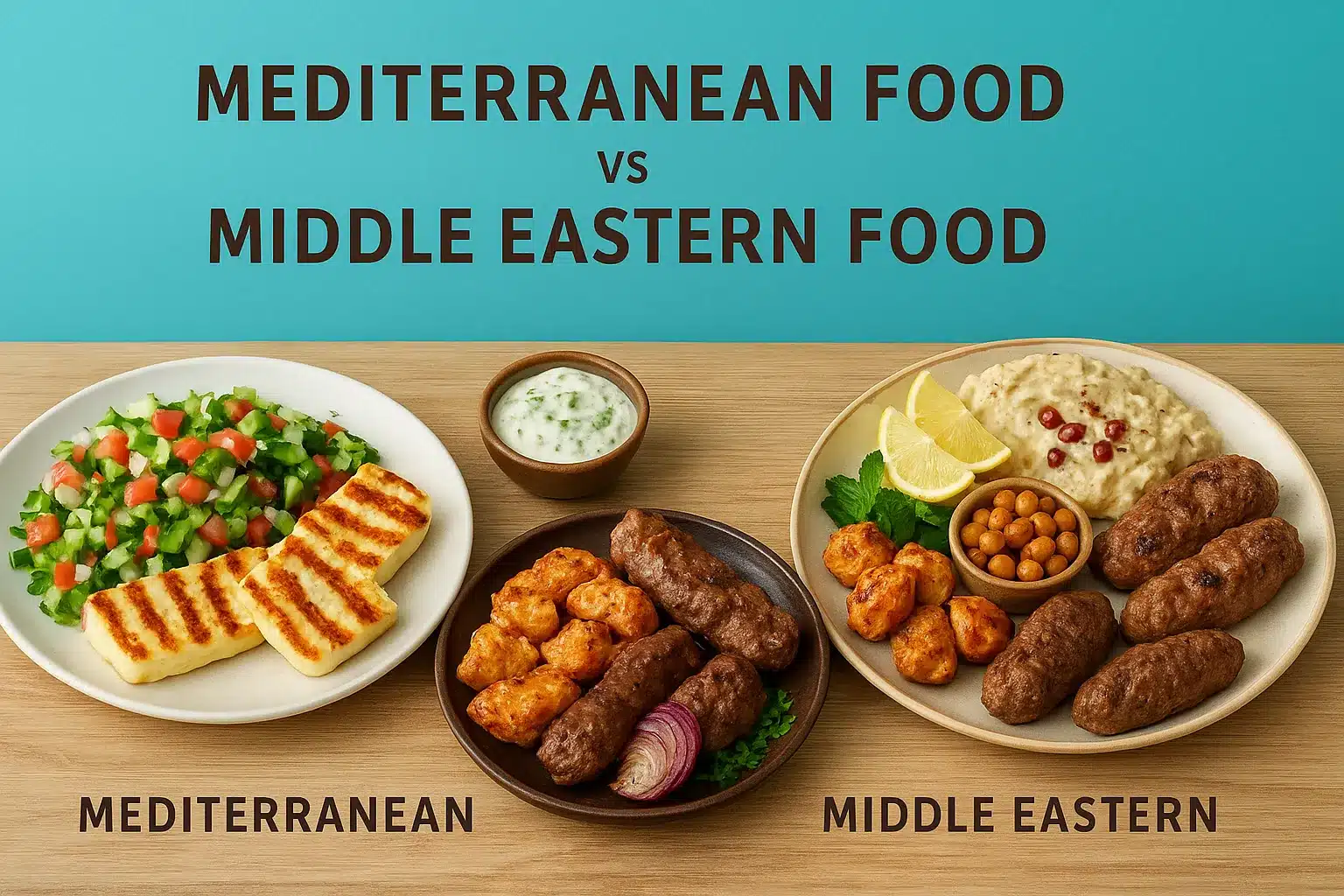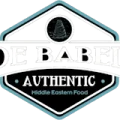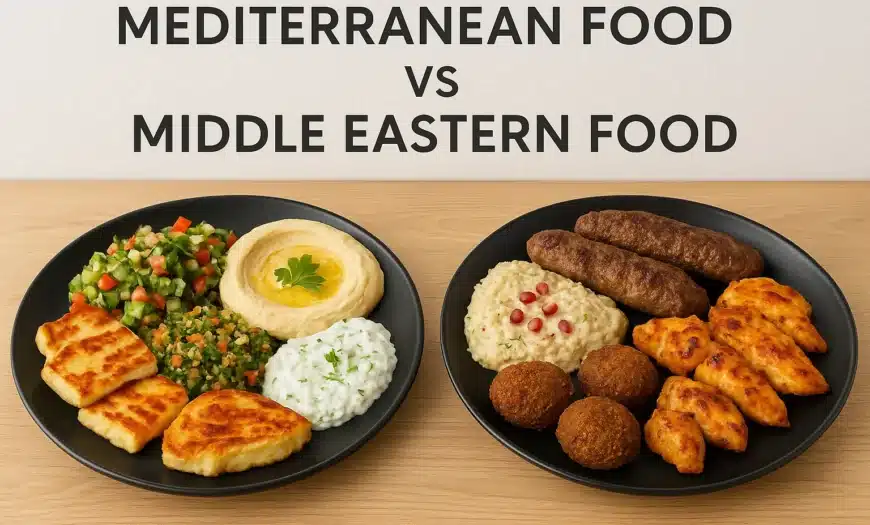Mediterranean Food vs Middle Eastern Food
The debate of Mediterranean food vs Middle Eastern food often creates confusion for diners. Both cuisines share ingredients such as olive oil, legumes, and flatbreads, but their identities are shaped by distinct cultures, geographies, and cooking traditions. Understanding the differences helps you appreciate each cuisine more deeply. At De Babel in Scottsdale, both worlds meet on a single menu, allowing guests to explore fresh Mediterranean flavors and bold Middle Eastern spices in one place.What Is Mediterranean Food?
Geographic Origins of Mediterranean Cuisine
The Mediterranean basin stretches from Southern Europe (Italy, Greece, Spain) to North Africa (Morocco, Egypt, Tunisia) and the Levant (Turkey, Lebanon, Israel). The cuisine reflects centuries of trade, cultural exchanges, and access to fertile lands and coastlines.Core Mediterranean Ingredients
Mediterranean food emphasizes balance and simplicity. Common staples include:- Olive oil as the foundation of cooking and dressing
- Herbs such as oregano, basil, rosemary, and mint
- Vegetables like tomatoes, cucumbers, peppers, and eggplant
- Legumes including lentils and chickpeas
- Whole grains such as bulgur, couscous, and orzo
- Seafood as a primary protein, complemented by poultry and lean meats
Mediterranean Cooking Methods
Cooking is typically light: vegetables are roasted or grilled, meats are prepared over open flames, and sauces remain minimal. Lemon juice, olive oil, and fresh herbs often replace heavy cream or butter. This keeps the cuisine fresh, digestible, and aligned with the globally recognized Mediterranean diet.What Is Middle Eastern Food?
Regions That Define Middle Eastern Cuisine
Middle Eastern cuisine spans the Levant (Lebanon, Syria, Jordan, Palestine), the Arabian Peninsula, Iraq, Iran, Turkey, and parts of North Africa. Each subregion contributes distinct influences: Persian rice dishes, Levantine mezze culture, Turkish kebabs, and Arabian grilled meats.Middle Eastern Spices and Seasonings
The Middle East is famous for its spice complexity. Blends such as zaatar, baharat, and sumac define flavor profiles. Common seasonings include cumin, coriander, cinnamon, turmeric, allspice, and cardamom. Tahini, pomegranate molasses, and garlic add depth to many dishes.Core Proteins and Staples
Proteins like lamb, chicken, and beef dominate the cuisine, often grilled over charcoal or cooked slowly in stews. Legumes such as chickpeas and lentils are equally essential. Flatbreads and rice form the backbone of meals, used to scoop dips or accompany kebabs. At De Babel, a Top rated Middle Eastern Restaurant Scottsdale, authentic Middle Eastern flavors are present in Chicken Tawook, Lamb Tikka, Meat Kafta, and slow-cooked dishes like Baba Ghanoush and Spicy Lentil Soup.Want to taste the best of both Mediterranean and Middle Eastern cuisines? Explore the De Babel menu and find your new favorite dish.

Mediterranean Food vs Middle Eastern Food: Key Differences
| Aspect | Mediterranean Cuisine | Middle Eastern Cuisine |
| Flavors | Light, herbal, citrus-forward | Bold, aromatic, spice-driven |
| Proteins | Fish, seafood, chicken, legumes | Lamb, chicken, beef, legumes |
| Cooking Methods | Grilling, roasting, simple sautés | Charcoal grilling, stewing, braising |
| Breads | Ciabatta, focaccia, pita, flatbreads | Pita, markouk, saj, khubz |
| Oils and Fats | Olive oil dominates | Olive oil, clarified butter, ghee in some areas |
| Sauces | Minimal, often olive oil and lemon based | Tahini, yogurt sauces, garlic-heavy dips |
Which Dishes Are Mediterranean and Which Are Middle Eastern?
Hummus:
Hummus has Middle Eastern origins, yet it has become a staple across the Mediterranean. At De Babel, hummus is freshly prepared daily and served with warm pita.Falafel:
Falafel is a Middle Eastern invention, often claimed by Egypt, but adopted into Mediterranean diets. De Babel serves falafel as sandwiches or platters, offering a plant-based option rich in flavor.Shawarma:
Shawarma is distinctly Middle Eastern, originating from Ottoman culinary traditions. At De Babel, the Chicken Shawarma Plate is one of the most popular entrees.Tabbouleh:
Tabbouleh is a Levantine salad made of parsley, bulgur, and lemon. It represents Middle Eastern freshness and is featured on De Babel’s menu.Gyros:
Gyros come from Greece, making them part of Mediterranean cuisine. At De Babel, the Gyro Sandwich offers a direct taste of this tradition.Dolmas or Grape Leaves:
Stuffed grape leaves are shared across both regions. The Mediterranean favors rice and herbs, while Middle Eastern variations often include lamb or spices. De Babel prepares grape leaves as a light yet flavorful appetizer.Why Do People Confuse Mediterranean and Middle Eastern Food?
Shared Ingredients:
Both cuisines rely on olive oil, legumes, garlic, and lemon.Similar Dishes with Different Names:
Shawarma and gyro are often compared, though they come from different traditions.Overlapping Geography:
Countries like Lebanon and Turkey border the Mediterranean while being culturally Middle Eastern.Restaurant Menus Combining Both:
Modern restaurants, including De Babel, intentionally blend the two. The Mezza Platter, featuring falafel, hummus, and grape leaves, illustrates the connection.Influence of the Mediterranean Diet:
The global popularity of the “Mediterranean diet” often groups Middle Eastern dishes under its umbrella, even when they have unique cultural origins.Mediterranean Diet vs Middle Eastern Diet
Key Features of the Mediterranean Diet
- Plant-based foods dominate, including vegetables, legumes, and grains
- Olive oil as the main fat
- Moderate consumption of fish and poultry
- Red wine in some European regions
Key Features of the Middle Eastern Diet
- Higher reliance on protein-rich dishes like lamb, chicken, and beef
- Use of lentils, chickpeas, and rice
- Complex spice blends and marinades
- Mezze culture emphasizing shared small plates
Health Benefits of Both
Both diets provide balanced nutrition, with proven benefits for heart health and longevity. At De Babel, you can experience both sides: the simplicity of a Chopped Salad, the heartiness of a Mix Grill Platter, or the comfort of Spicy Lentil Soup.Cultural and Historical Influences on Both Cuisines
Trade Routes and Spice Exchange
The Mediterranean Sea and Silk Road facilitated the movement of spices, rice, and citrus fruits, shaping both cuisines over centuries.Religious and Cultural Traditions
Christian, Muslim, and Jewish dietary laws influenced how food is prepared and consumed. Practices such as halal, kosher, and fasting periods left lasting culinary marks.Migration and Global Spread
Immigration carried falafel, shawarma, and kebabs into international street food culture, while pasta, pizza, and paella became Mediterranean ambassadors worldwide.Mediterranean and Middle Eastern Food in Scottsdale, Arizona
Why Diners Search for “Mediterranean Food”
In the United States, the term “Mediterranean food” has become synonymous with healthy, fresh, and flavorful meals, making it a popular search among Scottsdale residents.Demand for Fresh Lunch Options
Busy professionals and families alike prefer balanced meals like wraps, salads, and grilled plates for lunch. Both Mediterranean and Middle Eastern cuisines naturally provide these options.De Babel as a Local Leader Since 2021
Since opening in July 2021, De Babel has:- De Babel Yelp: Achieved a five-star rating
- Earned recognition as one of Yelp’s Top 100 Places to Eat in the U.S.
- Gained a reputation for authenticity, freshness, and exceptional hospitality
Experience Both at De Babel in Scottsdale
At De Babel, diners experience both Mediterranean freshness and Middle Eastern boldness on a single menu. Signature offerings include:- Quick Lunch Sandwiches: Falafel, Shawarma, Gyro, Chicken Tawook
- Hearty Entrees: Mix Grill Platter, Lamb Tikka, Chicken Shawarma Plate
- Fresh Salads and Appetizers: Tabbouleh, Baba Ghanoush, Fried Cauliflower
- Desserts: Baklava, Rice Pudding, Tahini Ice Cream



